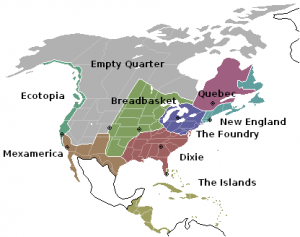4.6 Audience Segments: Geographics
We all understand geographically-defined political jurisdictions such as cities, counties, and states. These are important geographic audience categories for politicians and for news stories or ads about politics and elections. Also, local retail advertisers want to reach audiences who are in the reading or listening range of the local newspaper or radio station and within traveling distance of their stores. The audience for a newspaper is generally defined as those within a specific metropolitan area–stories and ads are written to appeal to the residents of a well-defined locality. Local television stations tailor their messages to the audience reached by their broadcast signal.
Larger, more abstract geographic definitions help define the audience for national advertisers and those creating news or public relations messages for a regional or national audience. Washington Post reporter Joel Garreau (1989) argued that regional differences in North America (Canada, the U.S., and Mexico) are important markers for understanding differences in populations that span a continent. He invented nine “nations” or non-political regions whose boundaries don’t correspond to any current political jurisdictions. They are New England, The Foundry, Dixie, The Islands, MexAmerica, Breadbasket, Ecotopia, The Empty Quarter, and Quebec.

For one example of how Garreau determined the boundaries for each “nation,” we can look at his examination of three major cities in Texas. By political considerations, the three are all part of one jurisdiction: the state of Texas. But to Garreau, Fort Worth is actually part of the Breadbasket because of its strong cattle-town heritage; San Antonio, with its large, urban Spanish-speaking community fits into MexAmerica; and Dallas is part of Dixie, with dramatic social change and economic growth.
These distinctions may be irrelevant to those who draw political boundaries, but the cultural implications are crucial for those who create messages. Audience members for some types of messages in San Antonio cannot be characterized as “Texans” or even “Southerners” if one of their main cultural and regional identifiers is their close affiliation with other inhabitants of “MexAmerica.” Garreau’s characterizations have been widely accepted by media professionals, businesses and social scientists around the country.
Another geographic definition segments audiences into rural, urban, suburban, and edge communities (the office parks that have sprung up on the outskirts of many urban communities). These geographic categories help define rifts between regions on issues such as transportation, education, taxes, housing and land use.
Politicians have long understood that voters can be defined using these types of categories. Those who create media messages pay attention to these categories as well. Newspaper publishers in major metropolitan areas, for example, have long struggled with how to maintain their focus on the central city that defines the newspaper, while also attracting and keeping readers who live in the suburbs and work in an edge community high-rise office building.
Demographic and geographic audience characteristics are gathered from many sources. These include the U.S. Census as well as thousands of individual studies and research services conducted by media industry professionals.

